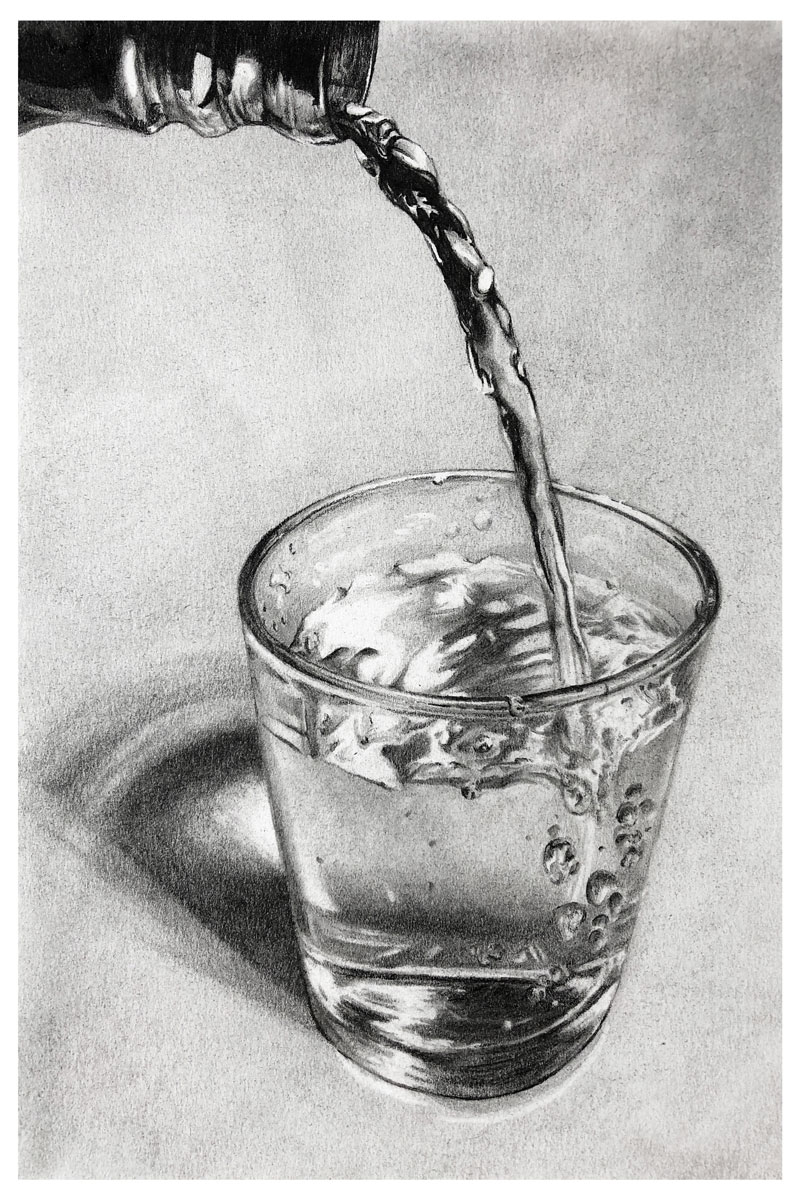Realistic Pencil Drawing: Sighting - Glass of Water
Course Curriculum
Lesson Description
In this lesson series, we’ll draw an accurate drawing of a glass of water with different grades of graphite, powdered graphite and a precise eraser. We'll use sighting and measuring to ensure accuracy in the drawing.
Lesson 1 - Materials and Sighting
In this lesson, we take a look at the materials used to complete the drawing. We use sighting and measuring to place the subjects within the picture plan and create the contour line drawing.
Lesson 2 - Bottle and Water Stream
In this lesson, we begin developing the value and texture of the bottle and water stream at the top of the picture plane.
Lesson 3 - Upper Glass and Water
In this lesson, we continue working down the picture plane, addressing the upper portion of the glass and water.
Lesson 4 - Finishing the Glass of Water
In this lesson, we complete the drawing by addressing the bottom of the glass and cast shadow behind it.

Lesson Materials
- Stonehenge Polar White Drawing Paper
- Lead Holder
- Graphite Grades (2H, HB, 2B, 4B)
- Blending Stumps
- Precise Vinyl or Plastic Eraser (Tombow Mono)
- Kneaded Eraser
- Powdered Graphite
- Mop Brush
Lesson Resources
References
Download eBook
Photo Reference
Finished Drawing

Love these lessons I am having a lot of fun. Matt you are an extraordinary Instructor so glad I found your classes.
Having just begun to learn to draw, I’m focusing on learning to draw realistic, representational images using graphite. Though I’m tempted to venture into other media (pen and ink which will be my next venture, colored pencils, watercolor, line and wash), for now I’m focused mainly on graphite. (Guess it stems from my love of b/w photography.) All that’s to say, I really appreciate these lessons. Thanks so much for providing them.
So I have a question in regards to arches (or any) cold press paper and graphite. I recently read a book on realistic animal drawing where the artist only used cold pressed paper and a layering process. I was curious if you have tried this method and what your thoughts are on the topic.
Using on hatching, cross hatching, no blender, rarely eraser. Would be cool live lesson imo.
What is powdered graphite? I cannot find it at the art supply stores I shop at in Canada. Is there something else I can use ?
Get graphite stick and use razor on side. Or just use your pencil with sandpaper over a plate to catch powder.
Hi Lynne, Yes, hard to find in Canada. Trever already gave you a good tip. If you can find woodless graphite pencils (just make sure they are graphite, not charcoal) you can simply rub those on 150 grit sandpaper then shake the powder into a dish or use a metal funnel over a small jar. Or, you can use a sharp knife (X-acto type) as suggested by Trever as well. There are a few suppliers online that carry the powder in jars such as Delta Art and Opus Art but it quickly becomes expensive.
Can you please clarify the paper size for the Water Glass exercise? The Polar White Stonehenge comes in 22.25 x 30.5 sheets. I was not sure what size to cut it, so I used PS to find the actual size of the finished drawing. Then I made the photo reference equal to finished drawing, and used a ruler to compare exact distances. I am not sure I got the point of the measuring and mapping part of the lesson. Maybe if I know the dimension of the paper you are working with, it will make more sense.
Hi Susan,
Measuring and mapping can be approached differently depending on your resource – photo or life. You could definitely do what you did by printing out the photo and making your drawing surface exactly the same size. Using a ruler may prove to be too cumbersome, so you may get used to using your pencil to save time. You can also observe the reference image placed on an easel or even on your computer. By stretching out your arm, you can take a measurement with your pencil and then mark the measurements on your paper. In this case, the size of the paper is really irrelevant. Obviously, you can use this method in the same way with a live subject. It’s not a perfect method, but it does help to get relationships of angles, shapes, etc. in place proportionally. You may check out this lesson for some further clarification…https://thevirtualinstructor.com/members/25-days-to-better-drawings-day-nineteen-sighting-measuring-and-mapping/
Matt, is there a difference between stonehenge polar white 90lb drawing paper and regular white paper?
Matt, I am so proud. I just finished the falcon and it’s really a success for me. And I learned that being patient ends with a great result. I’m very happy with may drawing. Youppi! Thank you. Now, the gass of water.
Awesome to hear, Lucie!
Matt, thank you for these wonderful lessons. I have not been able to get the ebooks however. Is there something I am not accessing correctly.
Hi Cheri,
Look for the “Resources” tab above these comments and below the video. There you will find a link to open the ebook for this module.
This is amazing!